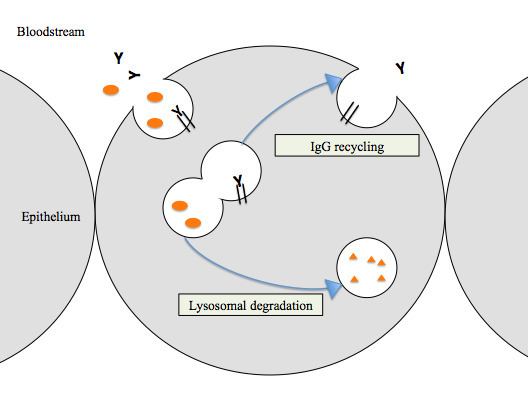Symbol FCGRT HUGO 3621 RefSeq NM_004107 | Entrez 2217 OMIM 601437 UniProt P55899 | |
 | ||
The neonatal Fc receptor (FcRn), also known as the Brambell receptor, is a protein that in humans is encoded by the FCGRT gene.
Contents
The neonatal Fc receptor is an Fc receptor which is similar in structure to the MHC class I molecule and also associates with beta-2-microglobulin. It was first discovered in rodents as a unique receptor capable of transporting IgG from mother's milk across the epithelium of newborn rodent's gut into the newborn's bloodstream. Further studies revealed a similar receptor in humans, leading to the naming as a neonatal Fc receptor. In humans, however, it is found in the placenta to help facilitate transport of mother's IgG to the growing fetus and it has also been shown to play a role in monitoring IgG turnover. Neonatal Fc receptor expression is up-regulated by the proinflammatory cytokine, TNF-α, and down-regulated by IFN-γ.
Transcytosis and recycling of IgG
FcRn helps transport IgG from the gut to the bloodstream. FcRn-mediated transcytosis of IgG across epithelial cells is possible because FcRn binds IgG at acidic pH (<6.5) but not at neutral or higher pH. Therefore, FcRn can bind IgG from the slightly acidic intestinal lumen and ensure efficient, unidirectional transport to the basolateral side where the pH is neutral to slightly basic.
This receptor also helps with the recovery of IgG in adults through the process of endocytosis in endothelial cells. FcRn in acidic endosomes bind to IgG internalized through pinocytosis, recycling it to the cell surface and releasing it at the basic pH of blood, and thereby preventing IgG from undergoing lysosomal degradation. This mechanism may provide an explanation for the greater half-life of IgG in the blood compared to that of other antibody isotypes (3 weeks). It has been shown that conjugation of some drugs to the Fc domain of IgG significantly increases their half-life.
Role in various organs
FcRn is expressed on antigen-presenting leukocytes like dendritic cells and is also expressed in neutrophils to help clear opsonized bacteria. In the kidneys, FcRn is expressed on epithelial cells called podocytes to prevent IgG from clogging the glomeruli and albumin from being excreted. Current studies are investigating FcRn in the liver because there are relatively low concentrations of both IgG and albumin in liver bile despite high concentrations in the blood. Studies have shown that FcRn-mediated transcytosis is involved with the trafficking of the HIV-1 virus across genital tract epithelium.
Therapeutic potential
Several autoimmune disorders are caused by the reaction of IgG to self antigens. New therapies seek to disrupt the IgG-FcRn interaction to increase the clearance of pathogenic IgG antibodies from the body. One such therapy is the infusion of intravenous immunoglobulin (IVIg) to bind available FcRn and prevent pathogenic IgG binding, thereby increasing pathogenic IgG removal. This strategy of blocking the binding of autoantibodies to FcRn by injecting higher affinity antibodies can help prevent inflammation in response to self antigen.
There are several drugs on the market that have Fc portions fused to the effector proteins in order to increase their half-lives through FcRn. They include: Amevive (alefacept), Arcalyst (rilonacept), Enbrel (etanercept), Nplate (romiplostim), Orencia (abatacept) and Nulojix (belatacept). Enbrel (etanercept) was the first successful IgG Fc-linked soluble receptor therapeutic and works by binding and neutralizing the pro-inflammatory cytokine, TNF-α.
